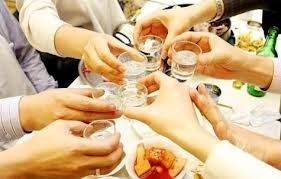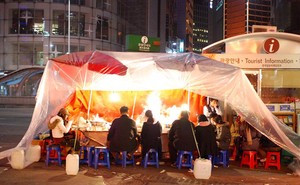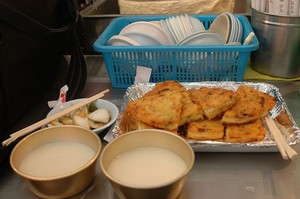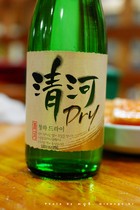If you enjoy having a drink or two, you'll have no problem feeling right at home in Korea. The consumption of alcohol is highly accepted here and is considered the ultimate way to create a friendly social setting, so the best way to understand true Korean culture is by learning the social rules and etiquette that accompanies Korean drinking culture.

mixed drink of soju and beer(Sso maek) |
Why Koreans go for a drink

To form close relationships
Korean love to take part in "hoesik", outings where co-workers dine and drink together after work. Comparable to the western concept of "happy hour", many drinks are poured all around during hoesik, creating a relaxing environment. Koreans believe that you must dine together or drink together in order to create friendships and get to know one another. For that reason, they will organize groups together and arrange for events to go drinking together. Whenever there's a new student or colleague, a guests needs to be entertained, or a person is visiting from another country, it's safe to say that alcohol always makes an appearance.
End-of-year parties
Although bars and pubs have a steady flow of customers throughout the year, the busiest time is always towards the end of the year. In Korea, the end of a year holds a special meaning; it's a time of the year where co-workers, clubs and organizations, classmates, and any other organized groups will all get together to look back at the year they've spent together and toast to another year together.
Drinking Etiquette
the most important thing about South Korea drinking culture is manner. So Koreans believe drinking etiquette to be important. When people can drink alcohol, they taught to how to drink with other people by elders to pupils. Because Korean ancestors thought that pouring and receiving drinks was important over the bowl.
Pouring drinks
When a person gives an alcoholic drink to adults, the person has to give the drink with two hands respectfully. When pouring a drink, the cup should be held with the right hand, and the wrist of your right hand held lightly with the left hand. Fill empty cups immediately.

Receiving drinks
When receiving drinks same as pouring drinks. When elders give to younger, younger's attitude is politely receiving. Also they say to elder "Thank you" and the next step is a little bit hit the bottle in the second place put down bottle. It makes elders pleased. Also when drinking beer turn younger's head.
Aspects of Confucian culture still remain in Korean culture so there are many traditional customs that are observed when drinking or dining. It's always good to observe the customs of the country you're in, but don't worry about offending others if you're less than perfect in remember all of the social rules. Just remember that politeness and respect for your elders is of the utmost importance, as many of the rules reflect this.
Respect your elers
It is not considered proper to pour the first glass unless you're the oldest person in the group or if you have the highest ranking social or work position. As a foreigner, you will most likely be considered the guest for the evening and thus not likely be faced with this responsibility. In addition to the elders pouring the first drink, it is polite to refrain from drinking until someone has poured your drink for you. Also, when drinking in front of an elder, it is polite to turn your head to the side when taking a shot or a sip instead of facing that person straight on. As a foreigner if you feel this is awkward, you may just bow your head down slightly in respect.
Always use both hands
In Korea, whenever you receive something, whether it's a gift or a drink, it is considered polite to use two hands. So when someone is pouring you a drink, you should hold out your glass or shot with both hands. This goes for when you pour someone else a drink as well. You may hold the bottle with both hands when pouring, or you may hold the bottle with one hand and use the other hand to support that arm by folding it and placing that hand on the pouring arm's inner elbow.
Refilling glasses
In many cultures it is considered acceptable, even rude, to not refill a person's glass before it is empty. In Korea however, it is the opposite. You should only refill someone's glass when there isn't a single drop left in it.
Drinking rules for females
Unlike in Japanese drinking culture, females are not obligated to pour anyone's drink. In fact, if a woman performs this task, it reflects poorly on her image because it is a reminder of the time period of when only women used to serve men in bars. In this day and age, women are not charged with this responsibility, but among friends it is considered an acceptable practice.
Binge drinking
Many people in Korea enjoy drinking and drinking culture. Unfortunately just like in any other country, there are those that enjoy their drink too much. This is partially due to a popular drink in Korea called poktanju, which literally translates to "bomb alcohol". This potent drink is a mixture of soju and beer. It's great to drink if you can handle your alcohol, but please drink responsibly.
Where to go for a drink
For hoesik, end-of-year parties or any other drinking occasion, Koreans will enjoy several "cha", phases of social activity. The first cha usually takes place at a restaurant where people will have dinner together. Then the group will move to a bar for the second cha. Sometimes the group will even move to another bar for a third cha, and the more daring will enjoy several more cha. For the first cha, Korean barbeque meat restaurants are the most popular among Koreans, although the first cha can be enjoyed at just about any dining establishment. Starting from the second cha, Koreans will go to any of the drinking establishments listed below. Noraebang (karaoke) is also very popular.
Min-sok-ju-jum (traditional Korean bars)
Korean minsokjujum are very similar to the Japanese izakaya. These places typically serve Korean "anju" with their Korean alcohol, snacks that are eaten while consuming alcohol. Koreans always snack on food while drinking, and as such, anju is a very important part of Korean drinking culture. Anju is comparable to pub food, but instead of burgers and fries, Koreans will snack on pajeon (a savory Korean pancake), spicy stews and stir-fried dishes. Typical alcoholic beverages will include Korean rice wines like makgeolli or dongdongju, soju and beer. Prices are relatively low at these places, making them popular with students and young professionals. The biggest problem you'll come across at one of these places is trying to finish off all of the anju, as the serving sizes are usually very generous.
Po-jang-ma-cha (street carts of stalls)

Anyone who visits Korea needs to have at least one drink at a pojangmacha. A pojangmacha is a street cart or stall that sells food and/or beverages. You'll find pojangmacha all over Korea, but the ones you see on the street only sell snacks, not any alcohol. The pojangmacha bars are more like a giant version of these small food carts, but with more variety on the menu in terms of alcohol and anju, and tables for you to enjoy your evening. Korean seafood dishes, chicken dishes, and barbeque pork dishes are just some of the things you'll find on the anju menu here, and beer and soju are the beverages of choice to go along with them. Although a pojangmacha bar may not look like it's expensive, anju dishes here can cost just about as much as any other Korean bar, sometimes even more. Make sure you know how much the dishes are before you order to avoid any unwanted hassle.
HOF
A HOF is the Korean version of a german beer hall, and is what is considered to be a typical Korean bar. Beer is the drink of choice here, although the selection of beer is usually limited to Korean brands. Fried chicken and french fries are the most common items on the anju menu and prices are relatively inexpensive, with a 500cc mug of beer costing only about 4,000 to 6,000 won and anju ranging from around 12,000 to 20,000 won.
And More...
If you want to drink wine, you go to a wine bar. If you want to drink sake, you go to a Japanese isakaya. There are plenty of drinking places in downtown Seoul to choose from, each with their own speciality of alcoholic beverages.
Types of Alcoholic Beverages
Soju and makgeolli are generally considered the most representative examples of Korean alcoholic beverages, but Korean beer is consumed just as much. Recently wine has become popular as well, popping up on menus at bars and restaurants all over Korea.
Makgeolli

Makgeolli is a traditional Korean alcoholic beverage that has been a part of Korean drinking culture for many centuries. Made from a mixture of rice and wheat, rice farmers used to make it whenever they could spare the time. It has a soft, silky texture and goes down very easily, making it extremely easy to get very drunk very quickly if you're not careful. It has been said that makgeolli is very good for your skin and health (in moderation of course), making makgeolli a very popular drink among females.
Soju
When people think of Japan, they think of sake. France or Italy, people think of wine. As for Korea, the honor would indefinitely go to soju. There are two major types of soju; one type is made from diluted ethanol, while the other type is made from distilled starches like sweet potatoes or wheat. The majority of soju you'll find in Korea will be of the former. Korean soju is about 19 - 21% alcohol by volume and is usually consumed straight from a shot glass. But unlike the western concept of drinking shots, Koreans will usually sip from their shot glasses of soju.
Beer
Beer is the world's most commonly consumed beverage, and can be found in Korea as well. The most common brands in Korea are Cass, Hite, OB and Max. Nearly every drinking establishment in Korea will serve one, if not all of these.
Poktanju
In Korea, many people like "poktanju". For examples are soju and beer (Sso maek), foreigner liquors and beer, and soju, beer and coke (kojingamlae) etc. Poktanju makes people drunken more fast. Nevertheless, people enjoy drinking it and drink it bottoms up. There are lots of Poktanju,
Yakju
Yakju (literally "medicinal alcohol") is a refined rice wine made from steamed rice that has gone through several fermentation stages. It is also called myeongyakju or beopju and is distinguished from takju by its relative clarity. Varieties include baekhaju, which is made from glutinous rice and Korean nuruk, and Heukmeeju, which is made from black rice.
Cheongju

Cheongju (literally "clear wine" or "clear liquor") is a clear rice wine similar to Japanese sake. One popular brand of cheongju is Chung Ha, which is widely available at Korean restaurants. There are various local variations, including beopju, which is brewed in the ancient city of Gyeongju.
Distilled liquors
Korean distilled liquors include goryangju and okroju. Another variety, called munbaeju, has the distinction of being South Korea's Important Intangible Cultural Property Number 86-1. Munbaeju is a traditional aged distilled liquor made of malted millet, sorghum, wheat, rice, and nuruk (fermentation starter), with a strength of 40 percent alcohol by volume. It originates in the Pyongyang region of North Korea and is noted for its fragrance, which is said to resemble the flower of the munbae tree (similar to a pear).

Log in to write a comment